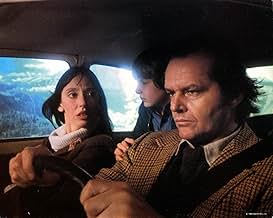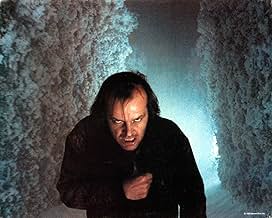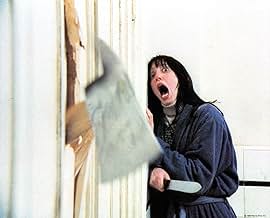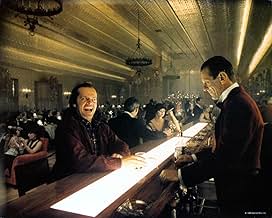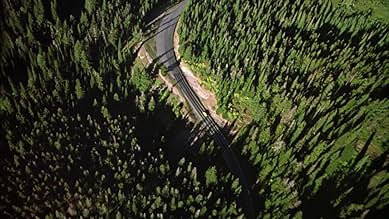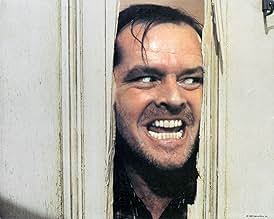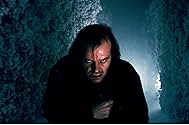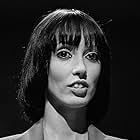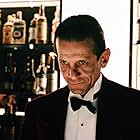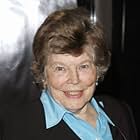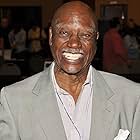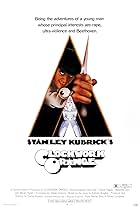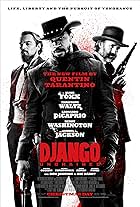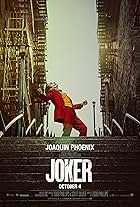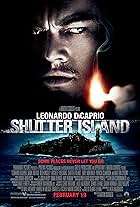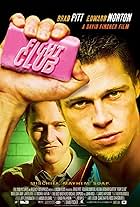A family heads to an isolated hotel for the winter, where a sinister presence influences the father into violence. At the same time, his psychic son sees horrifying forebodings from both the... Read allA family heads to an isolated hotel for the winter, where a sinister presence influences the father into violence. At the same time, his psychic son sees horrifying forebodings from both the past and the future.A family heads to an isolated hotel for the winter, where a sinister presence influences the father into violence. At the same time, his psychic son sees horrifying forebodings from both the past and the future.
- Awards
- 6 wins & 9 nominations total
- Director
- Writers
- All cast & crew
- Production, box office & more at IMDbPro
Storyline
Did you know
- TriviaBecause Danny Lloyd was so young, and since it was his first acting job, Stanley Kubrick was highly protective of the child. During the shooting of the movie, Lloyd was under the impression that the film he was making was a drama, not a horror movie. In fact, when Wendy carries Danny away while shouting at Jack in the Colorado Lounge, she is actually carrying a life-size dummy, so Lloyd would not have to be in the scene. He only realized the truth several years later, when he was shown a heavily edited version of the film. He did not see the uncut version of the film until he was seventeen, eleven years after he had made it.
- GoofsDuring the long shot of the Overlook Hotel in the beginning (right before The Interview title card), the maze cannot be seen, though throughout the rest of the movie it is rather close to the hotel.
- Quotes
Jack Torrance: Here's Johnny!
- Crazy creditsAfter the 146 minute version of the film was met with poor reviews and weak box office in the US, Stanley Kubrick re-edited the film for European release, removing 24 minutes of footage. Included in the removed footage were the entire performances of Anne Jackson as the Doctor and Tony Burton as Larry. However, both Jackson and Burton's names were still listed in the opening credits despite them no longer appearing in the film.
- Alternate versionsABC edited 4 minutes from the film for its 1983 network television premiere.
- ConnectionsEdited into Hai-Kubrick (1999)
- SoundtracksThe Shining (Main Title)
Written by Wendy Carlos and Rachel Elkind
Performed by Wendy Carlos and Rachel Elkind
Based on "Dream of a Witches' Sabbath"
From Symphonie Fantastique by Hector Berlioz (traditional requiem "Dies Irae")
Featured review
Sometimes all good horror needs is a good idea. But sometimes, rarely indeed, a horror masterpiece will reach us by the hand of a Kubrick, with the adept, elusive touch of a great artist to guide the vision, and we know what separates it from all else.
Okay, the story has enough promise that even a hired gun would have to try to fail. Heck, even Stephen King himself didn't fare so bad. It's how Kubrick perceives King's universe however, how he fills the frame with it, that renders THE SHINING a feast for the senses.
Horror that will reach us through the mind and body alike, an assault as it were, tending eventually its pitch to a crescendo, yet curiously not without a delicate lull.
Kubrick's cinema is, as usually, a sight to behold. We get the adventurous camera that prowls through the lavish corridors of the Overlook Hotel like it is some kind of mystic labyrinth rife for exploration, linear tracking shots exposing impeccably decorated interiors in symmetric grandeur. The geometrical approach in how Kubrick perceives space reminds me very much of Japanese directors of some 10 years before. In that what is depicted in the frame, the elements of narrative, is borderline inconsequential to how they all balance and harmonize together.
Certain images stand out in this. The first shot of Jack's typewriter, ominously accompanied by the off-screen thumps of a ball, drums of doom that seem to emanate from the very walls or the typewriter itself, an instrument of doom in itself as is later shown. A red river flowing through the hotel's elevators in a poetry of slow motions. Jack hitting the door with the axe, the camera moving along with him, tracking the action as it happens, as though it's the camera piercing through the door and not the axe. The ultra fast zoom in the kid's face violently thrusting us inside his head before we see the two dead girls from his POV. And of course, the epochal bathroom scene.
Much has been said of Jack Nicholson's obtrusive overacting. His mad is not entirely successful, because, well, he's Jack Nicholson. The guy looks half-mad anyway. Playing mad turns him into an exaggerated caricature of himself. Shelley Duvall on the other hand is one of the most inspired casting choices Kubrick ever made. Coming from a streak of fantastic performances for Robert Altman in the seventies (3 WOMEN, THIEVES LIKE US, NASHVILLE), she brings to her character the right amounts of swanlike fragility and emotional distress. A delicate, detached thing thrown in with the mad.
Okay, the story has enough promise that even a hired gun would have to try to fail. Heck, even Stephen King himself didn't fare so bad. It's how Kubrick perceives King's universe however, how he fills the frame with it, that renders THE SHINING a feast for the senses.
Horror that will reach us through the mind and body alike, an assault as it were, tending eventually its pitch to a crescendo, yet curiously not without a delicate lull.
Kubrick's cinema is, as usually, a sight to behold. We get the adventurous camera that prowls through the lavish corridors of the Overlook Hotel like it is some kind of mystic labyrinth rife for exploration, linear tracking shots exposing impeccably decorated interiors in symmetric grandeur. The geometrical approach in how Kubrick perceives space reminds me very much of Japanese directors of some 10 years before. In that what is depicted in the frame, the elements of narrative, is borderline inconsequential to how they all balance and harmonize together.
Certain images stand out in this. The first shot of Jack's typewriter, ominously accompanied by the off-screen thumps of a ball, drums of doom that seem to emanate from the very walls or the typewriter itself, an instrument of doom in itself as is later shown. A red river flowing through the hotel's elevators in a poetry of slow motions. Jack hitting the door with the axe, the camera moving along with him, tracking the action as it happens, as though it's the camera piercing through the door and not the axe. The ultra fast zoom in the kid's face violently thrusting us inside his head before we see the two dead girls from his POV. And of course, the epochal bathroom scene.
Much has been said of Jack Nicholson's obtrusive overacting. His mad is not entirely successful, because, well, he's Jack Nicholson. The guy looks half-mad anyway. Playing mad turns him into an exaggerated caricature of himself. Shelley Duvall on the other hand is one of the most inspired casting choices Kubrick ever made. Coming from a streak of fantastic performances for Robert Altman in the seventies (3 WOMEN, THIEVES LIKE US, NASHVILLE), she brings to her character the right amounts of swanlike fragility and emotional distress. A delicate, detached thing thrown in with the mad.
- chaos-rampant
- Nov 23, 2008
- Permalink
- How long is The Shining?Powered by Alexa
Details
- Release date
- Countries of origin
- Language
- Also known as
- El resplandor
- Filming locations
- Timberline Lodge, Mount Hood, Oregon, USA(Overlook Hotel; exterior)
- Production companies
- See more company credits at IMDbPro
Box office
- Budget
- $19,000,000 (estimated)
- Gross US & Canada
- $45,634,352
- Opening weekend US & Canada
- $622,337
- May 26, 1980
- Gross worldwide
- $47,962,534
Contribute to this page
Suggest an edit or add missing content








